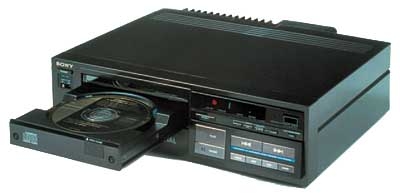The CD: 16 Bits and 20 Years Page 3
Beyond the fundamental technology, a look at the Sony CDP-101 reviewed in that 1982 article reveals that some of its features were themselves trend-setting. Take its slide-out disc drawer, for instance - now virtually the standard way to get a disc into all kinds of players except car units, portables, boomboxes, and megachangers. The CDP-101 was the only first-generation player to have a disc drawer. The first Philips player had a pop-up lid, while all the others had some variation of a front-panel flip-down door, with the disc held vertically as in a cassette deck. Apparently competitors were surprised by Sony's move, since all its publicly displayed prototypes had been flip-down devices. The slick, smooth drawer operation, as well as its greater resistance to improper disc loading, were quickly adopted throughout the industry, with flip-down models disappearing in the second generation of players. 
Some seemingly trivial things made their debut with the CDP-101 and other players. The "next track" symbol (an arrowhead pointing into a vertical bar) was then brand-new but is now found on DVD players and even computer players and jukebox software. Infrared remote controls, like the one supplied with the CDP-101, got their biggest push with CD players. You need only glance at your coffee table to see how important that development was.
We hardly take notice anymore of the accurate track information (number and time) displayed on a player's front panel. But this welcome innovation was made possible by the CD format's provision for recording a table of contents as well as time codes on the disc, information that also enables the rapid and accurate cueing we take for granted with both CDs and DVDs.
Since the introduction of the CDP-101 and other players, we've seen the cost, size, and weight of CD players plummet and their portability increase to the point where you can get playback times of more than 12 hours on a single AA battery. Performance has improved, too, though not as much in recent years since the best players - which usually masquerade as DVD players - are now providing audio quality right at the theoretical limits of the 16-bit encoding system. (Thanks to Stanley Lipshitz and John Vanderkooy at the Univeristy of Waterloo in Ontario for helping establish those limits, on which we've based our player test procedures.)
Much of the improvement comes from the use of delta-sigma digital-to-analog (D/A) converter chips - often, mistakenly, called 1-bit converters - which enable very low-distortion conversion at low cost. Delta-sigma converters, now used in many industries, got their big initial push from the requirements of digital audio.
In addition to 2003 being the 20th anniversary of the introduction of the CD in the U.S., it's also been some 20 years since Toshi Doi, then head of Sony's CD program, took me aside during a break in a lecture/demonstration here in New York City to tell me that Sony was introducing the CD not to show off its technological prowess, or because it needed the hardware business, but "to save the music industry." It's a sad irony of history that, this miracle being accomplished, the very music industry that was saved is now trying to make CDs unplayable by loading them with anticopying features that violate the CD standard - that still-stunning landmark of audio innovation.
- Log in or register to post comments



































































